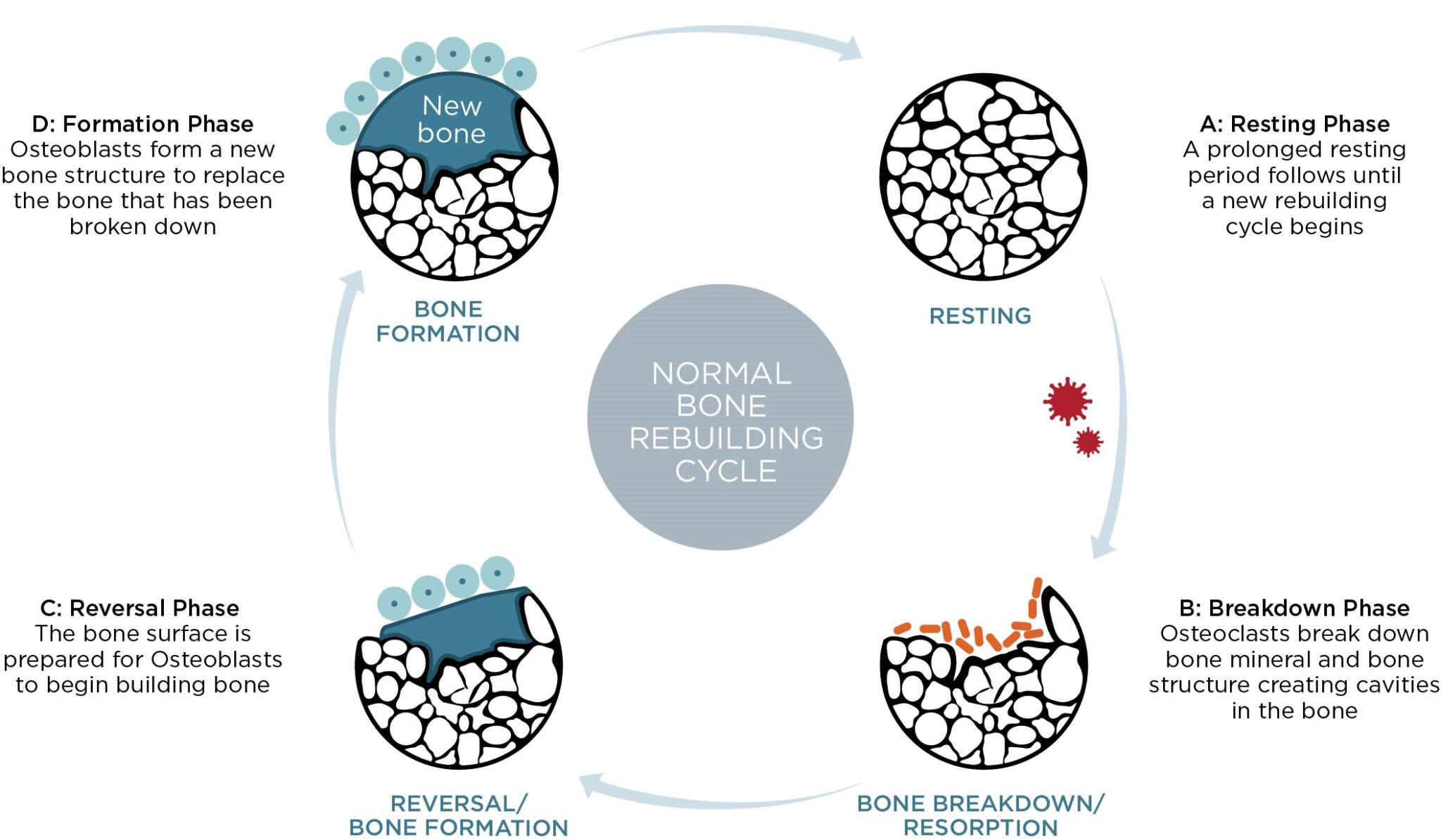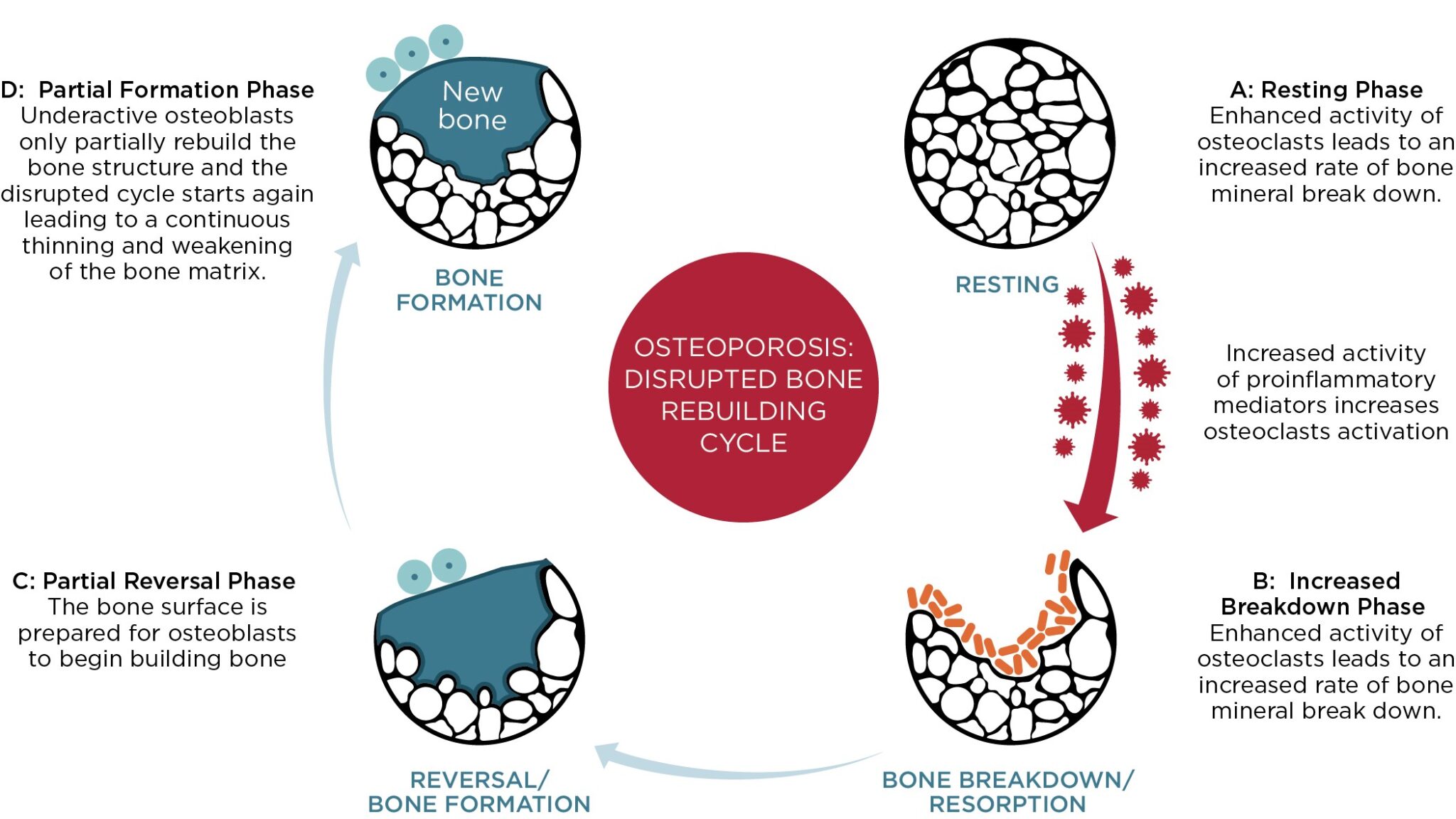The health of our bones is something that can often be taken for granted. As the bones are hidden, it’s hard to appreciate the overall health of our bones, often until it is too late.
Let’s start at the beginning.
Our bones are in a state of constant recycling. As a baby, we rebuild our whole skeleton in the first year, and as adults we replenish around 10% of our skeleton in a year. This constant cycle is needed to maintain healthy bone mass throughout life.
It’s important to support this where we can because we rely on our bones for so many functions. The most obvious thing is that they form the ‘frame’ of our body, they keep us upright and able to move around throughout life – but there’s a lot more to it.
Underpinning the health of the bones is the biological process that maintains bone health; the Bone Rebuilding Cycle.
The following diagram shows how a normal, healthy Bone Rebuilding Cycle works:

In normal circumstances, this process continues, and our bones remain strong. However, as we cannot see our bones, we can’t know how healthy they are. What’s more alarming is that issues with bone health, such as bone diseases, are often not diagnosed until AFTER you have suffered a number of breaks, signaling to healthcare professionals that there may be more happening beneath the surface.
The most prevalent bone disease in the UK is Osteoporosis, and the precursor condition called Osteopenia. As a matter of aging, we can expect some reduction of bone density, but when diseases such as these take hold, it means in simple terms our bones are now declining in health and density quicker than the body can rebuild them.
Bone diseases such as Osteoporosis are a signal that the Bone Rebuilding Cycle has been compromised, leading to weakened bone rebuilding and overall poorer bone health, as shown in the diagram below of a disrupted Bone Rebuilding Cycle:

The physical impact of a disrupted Bone Rebuilding Cycle can be seen in the image below, which shows how the bone mass gradually diminishes resulting in a weaker, less dense bone, leading to Osteoporosis:

From left to right, a healthy bone structure, leading to Osteoporotic bone.
Calcium is a vital mineral that serves many purposes in the body, such as helping to regulate your heartbeat, helping your muscles to contract, enabling nerves to send signals to your brain – and so much more
The bones are the only source of calcium in the body, and the human body cannot make calcium by itself, which is why it is recommended that we have a daily intake of calcium, through food or other means, to ensure that these vital functions can continue – as well as to ensure that the bones remain healthy and strong.
When the body can’t get enough calcium through the diet, it uses the bones as a ‘bank’ and withdraws the mineral into the bloodstream to help maintain all of these key processes. When bones are Osteoporotic, it results in higher levels of calcium being drawn into the blood, whilst the bones themselves are getting further depleted due to a weakening of the bone rebuilding cycle.

In the UK, Osteoporosis is the most significant bone disease by population, and it has a number of startling statistics that highlight the spread and severity of this ‘silent disease’:
There are a number of positive steps that we can all take to help to protect the health and strength of our bones over the longer term – and these apply even if you already have been diagnosed with a bone disease, although you may wish to seek the advice of a healthcare professional regarding exercise to ensure you are only working within your capabilities:
Smoking, alcohol and high amounts of sugar in the diet can all contribute to weakened regrowth of bones. Giving up smoking and heavily reducing the intake of alcohol and sugars can have a positive impact on bone health.

In addition to the above factors, daily nutrition is key to managing your bone health, whether you’ve already got a bone disease or you’re just looking to preserve your bones. Calcium and Vitamin D are probably the two most important tools in helping you to achieve healthier bones.
A regular intake of calcium, the main mineral that the body uses in the formation of bones, is essential. As mentioned, the body cannot produce calcium, and so we need to be conscious that we are getting it through our diet. It can be difficult to ensure that you’re getting enough calcium though, even with a well-balanced diet that includes calcium-rich foods. A few examples of foods that are rich in calcium are:
Vitamin D plays an important role too. One of the actions of vitamin D is helping to transport minerals like calcium into the body more efficiently. This helps to contribute to healthier bone rebuilding, and therefore aids with controlling conditions such as Osteoporosis.

Food supplements are an effective solution that are quick and easy to incorporate into your daily routines, and so it makes getting enough of these essential elements into your body a bit easier – when combined with a healthy balanced diet.
Unfortunately, the vast majority of calcium supplements available today utilise rock-based calcium. This is cheap to acquire and manufacture, but the main downside is that it’s hard for the body to absorb and effectively utilise.
One source of calcium, that is marine plant-derived can be found in LithoLexal® Bone Health. It is a unique, multi-molecular extract, that contains a highly bioavailable form of calcium, magnesium and over 70 additional trace minerals – with added vitamin D to ensure the absorption of these key ingredients.
Click below to find out why LithoLexal® is better than the alternatives: